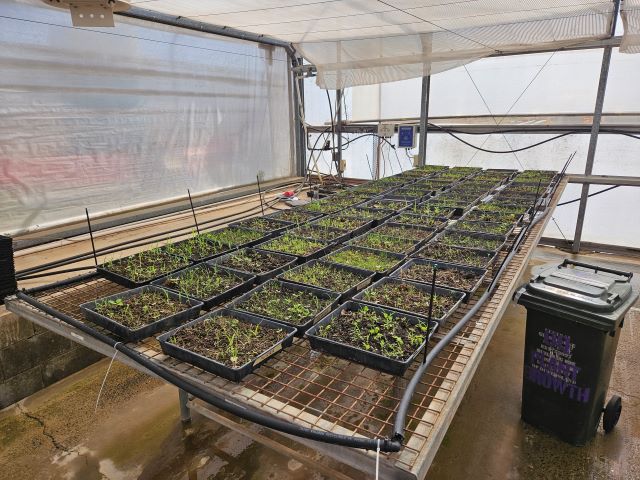Background
Fire has played a significant role in shaping the composition and functioning of a wide variety of ecosystems, and fire prone environments are reported to have distinctly high levels of biodiversity, species richness, and endemism (Bowman, et al 2016). However, the alteration of global fire regimes due to anthropogenic climate change, exotic species invasions, and fire suppression regimes, have caused declines in biodiversity in such areas. These stressors are highly interconnected and interact to create highly degraded, weedy landscapes.
There is evidence that the management of such landscapes with prescribed fire can restore native ecosystems by removing weedy biomass and promoting the germination of native species that were once present before invasion (McLoughlin 1997; Thomson & Leishman 2005). However, simply reinstating historical fire regimes fails to account for the changed response of vegetation to fire at such sites, due to the regime shifts induced by invasive species and fire suppression (Gaertner, et al 2014). For example, many exotic species can increase fuel biomass, connectivity and structure to create extreme fires that damage native vegetation (D’Antonio & Vitousek 1992). Thus, applying historical burning regimes to invaded landscapes will serve only to further these altered fire regimes. Rather, degraded landscapes may initially need more regular fire, i.e. yearly, for a period of a few years, to keep weedy biomass at bay and promote the re-establishment and resilience of native communities (Steffensen 2020}.
However, the effect of increased fire frequency may detrimentally affect other aspects of the community, such as the soil seed bank. In fire-prone landscapes, the soil seedbank plays an important role in restoration, as it acts as a “biodiversity reservoir”, and allows communities to persist and re-establish after fire (Vandvik, et al 2016). There are very few studies quantifying the effect of fire frequency on seedbanks, with varying results (Blodgett, et al 2012; Lewis, et al 2012; Cury, et al 2020).
Aims
1. Assess the risk that the seed bank is depleted after a single management burn Assess the impact of a single management burn on the below-ground germinable seed bank relative to:
- A) the control
- B) the above-ground community
- C) the ‘hidden’ diversity of the eDNA profile
2. Trial soil eDNA as a mechanism to quantify below-ground plant diversity
Methodology
In August of 2022, a management burn was conducted over approximately 0.5 x 0.5km of the Hiddenvale property. From this site, vegetation surveys and soil sampling were undertaken on 1x1m plots at 3 points along 10 transects (5 burnt sites, 5 controls on unburnt sites with similar vegetation composition approximately 50-100m away).
Thirty small soil cores were collected within each quadrat, each with a diameter of 4.48cm and a depth of 5cm, resulting in a surface area of 472.8cm2, and thus a sampling effort of just under 5%. Cores from each plot were mixed thoroughly together, and approximately 15g of soil was subsampled and frozen for eDNA analysis, which will be outsourced.
To quantify the soil seed bank, emergence trials were conducted on the remaining soil. Samples were split over two trays with a sand base to allow for a thinner spread to increase light penetration and germination. Trays were watered 4 times daily with misters that delivered approximately 40mL of water. Once able to be identified, seedlings were removed and counted; any unidentifiable seedlings were transplanted and grown to flower for further identification.

Expected Outcomes
We hope to aid land management and enhance our understanding of how multiple, higher frequency burns may affect the landscape by assessing the state of the germinable seed bank, above-ground vegetation, and ‘hidden’ diversity of the eDNA profile responds 1 year post burn. If eDNA analysis is incorporated, this project will give an indication if soil eDNA can be used to approximate the soil seed bank.
References
Bowman, D. M. J. S., Perry, G. L. W., Higgins, S. I., Johnson, C. N., Fuhlendorf, S. D. & Murphy, B. P. 2016, ‘Pyrodiversity is the coupling of biodiversity and fire regimes in food webs’, Philosophical Transactions of the Royal Society B: Biological Sciences, vol. 371, 20150169.
Blodgett, H., Hart-Fredeluces, G. & Stanislaw, M. 2012, ‘Annual burning decreases seed density in the upper soil layers of the seed bank’, Tillers, Grinnel College, vol. 2, pp. 31-38.
Cury, R. T. D. S., Montibeller-Santos, C., Balch, J. K., Brando, P. M. & Torezan, J. M. D. 2020, ‘Effects of Fire Frequency on Seed Sources and Regeneration in Southeastern Amazonia’, Frontiers in Forests and Global Change, vol. 3.
D'antonio, C. M. & Vitousek, P. M. 1992, ‘Biological invasions by exotic grasses, the grass/fire cycle, and global change’, Annual review of ecology and systematics, vol. 23, pp. 63-87.
Gaertner, M., Biggs, R., Te Beest, M., Hui, C., Molofsky, J. & Richardson, D. M. 2014, ‘Invasive plants as drivers of regime shifts: identifying high-priority invaders that alter feedback relationships’, Diversity and Distributions, vol. 20, pp. 733-744.
Lewis, T. O. M., Reif, M., Prendergast, E. & Tran, C. 2012, ‘The effect of long-term repeated burning and fire exclusion on above- and below-ground Blackbutt (Eucalyptus pilularis) forest vegetation assemblages’, Austral Ecology, vol. 37, pp. 767-778.
Mcloughlin, L. 1997, ‘The impact of planting for restoration of remnant bushland on its scientific and educational values: implications for conservation planning’, Pacific Conservation Biology, vol. 3, pp. 27-38.
Steffensen, V. 2020, Fire country: How indigenous fire management could save Australia, CSIRO Publishing.
Thomson, V. P. & Leishman, M. R. 2005, ‘Post-fire vegetation dynamics in nutrient-enriched and non-enriched sclerophyll woodland’, Austral Ecology, vol. 30, pp. 250-260.
Vandvik, V., Klanderud, K., Meineri, E., Måren, I. E. & Töpper, J. 2016, ‘Seed banks are biodiversity reservoirs: species–area relationships above versus below ground’, Oikos, vol. 125, vol. 218-228.
Acknowledgements
Thank you to Hidden Vale Research Station Support Funding Internal Grant Scheme



